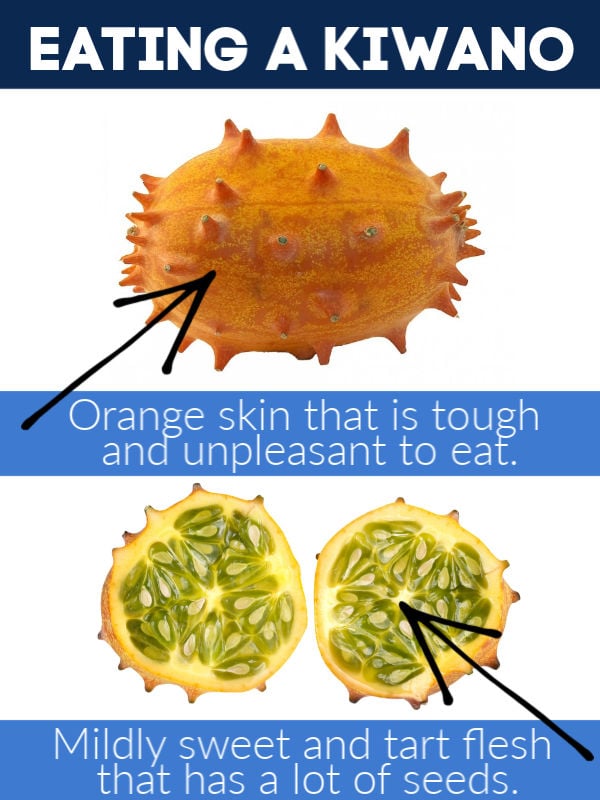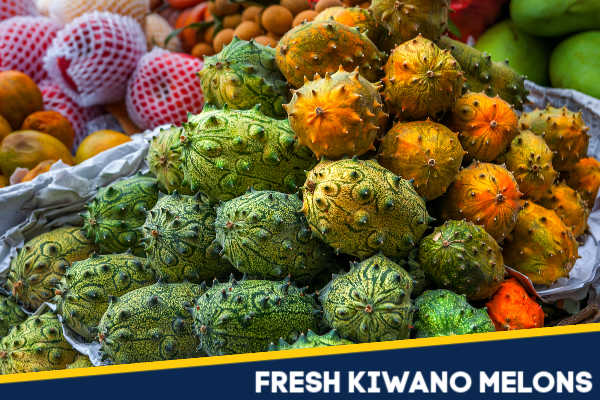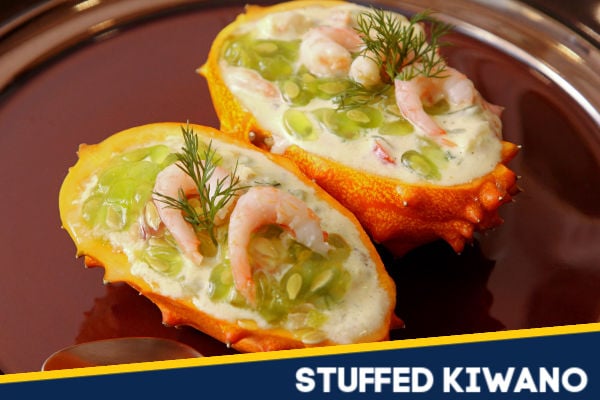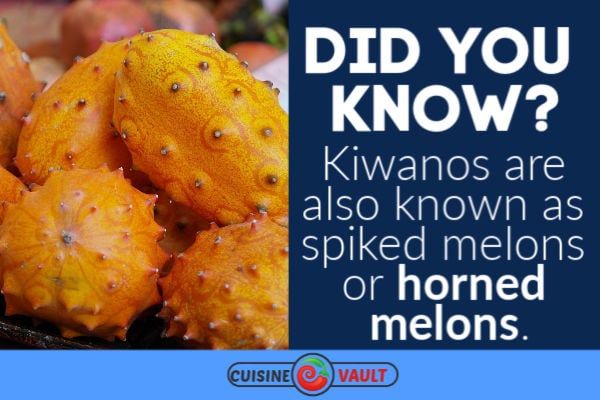The kiwano melon is an exotic fruit that is native to the sub-Saharan regions of Africa. It is easily recognized by its vibrant orange skin covered in spiky thorn-like projections. Kiwanos are starting to pop up in warmer parts of the United States, Europe, and New Zealand.
If you stumble onto this fruit at a market or while traveling abroad, you may want to know: what does a kiwano melon taste like? We’re about to take a close look at the fruit’s taste, texture, and how it can be used in the kitchen.
Describing the kiwano fruit taste
The kiwano melon is a mild tasting fruit that is slightly sweet and tart. Its closest comparison would be a cucumber, although it does have a subtle undertone of citrus and banana. The inner flesh is a pulpy gelatinous substance that feels a lot like aloe vera jelly.
As you slice into a kiwano fruit, you’ll notice liquid dripping out. They are laden with juice, which is ideal for drinking. It offers a pleasant taste combined with a range of health benefits. Once chopped, the aroma is pleasantly crisp with a summery feel to it.
Prefer to sit back and listen?
Throughout the fruit, there are masses of white seeds that are edible. They don’t have a lot of taste and are closer in texture to watermelon pips than cucumber seeds. Most “kiwano eaters” find the seeds unpleasant and discard them, rather than eating them.
 If you’re concerned that this is one of those fruits that has an overwhelming tropical aroma or taste, then you shouldn’t be concerned. It is nothing like durian or noni. If anything, the flavor is a little underwhelming, and extracting the edible fruit is a challenge, with the nest of seeds housed in every conceivable section of the interior.
If you’re concerned that this is one of those fruits that has an overwhelming tropical aroma or taste, then you shouldn’t be concerned. It is nothing like durian or noni. If anything, the flavor is a little underwhelming, and extracting the edible fruit is a challenge, with the nest of seeds housed in every conceivable section of the interior.
Other useful tropical fruits
Discover what an ackee tastes like.
We reveal details on the taste of jaboticaba.
Learn if the taste of pomelo is right for you.
How to eat a kiwano
It is essential to choose a ripe kiwano that’s full of juice. Look for fruits that have orange rind and spikes. A green-colored skin is a sign that the fruit is not ripe yet. Don’t be concerned by the spiky exterior; they aren’t overly sharp once reaching the store.
 It would help if you also gave the melon a gentle squeeze to ensure the inside isn’t too mushy and soft – there should be a little give, though. Once you have selected your kiwano, it’s time to eat! Here are some suggested cooking ideas.
It would help if you also gave the melon a gentle squeeze to ensure the inside isn’t too mushy and soft – there should be a little give, though. Once you have selected your kiwano, it’s time to eat! Here are some suggested cooking ideas.
Eaten out of hand
This option is the easiest. Place your fruit on a chopping board and slice it in half vertically. With the insides exposed, a spoon can easily scoop out the small segments of flesh and seed. It is virtually impossible to remove the seeds by hand, so your best option is to pop the whole spoonful in your mouth and then spit out the seeds. Of course, you can also eat the seeds if you enjoy them.
Tip: Add a sprinkle of sugar or salt before eating to enhance the flavor.
Beverages
Toss the whole fruit into a blender and process until thick liquid forms, then strain it into a bowl. Discard the pulp and enjoy the mild, refreshing taste of kiwano juice. You can also add this fruit to smoothies for increased nutritional value.
Breakfast
Use it on your favorite breakfast cereal, granola, or swirl it through a creamy yogurt. It’s relatively low in calories and high in protein, making this ingredient a healthy addition to your breakfast routine.
Stuffing
 The kiwano can be sliced in half vertically and then hollowed out and stuffed with your favorite fillings. Combine the fruit pulp with avocado and shrimp for a delicious and quick dinner option. The kiwano skin holds its shape well and looks impressive on the table.
The kiwano can be sliced in half vertically and then hollowed out and stuffed with your favorite fillings. Combine the fruit pulp with avocado and shrimp for a delicious and quick dinner option. The kiwano skin holds its shape well and looks impressive on the table.
Tip: A kiwano melon is at home in a savory dish as it is a dessert.
Desserts
Forget the caramel sauce next time you have ice cream or a sundae for dessert. Instead, smother them with kiwano pulp. A little like passionfruit, only you’ve upped the tropical factor.
Another dessert idea is to include them in a fresh fruit salad. Combine it with subtle-flavored fruit like rock melon so that the other flavors don’t overpower it.
Like most tropical fruit, kiwano melons are perfect for making sumptuous ice cream or sorbet.
Health benefits
The kiwano is exceptionally high in water content and low in fat, carbohydrates, and calories. Compared to other fruit, it is high in protein. An impressive 16% of its calories are from protein.
Kiwanos are high in antioxidants, vitamins, and minerals. A single melon will provide 21% of your daily requirement of magnesium and 18% of vitamin C.
Fast facts
- The kiwano melon is a part of the melon and cucumber family, and its scientific name is Cucumis metuliferus.
- Other names for the kiwano are the spiked melon, African horned cucumber, hedged gourd, horned melon, jelly melon, gaka, and melano.
- In the Kalahari desert's dry season, the kiwano is one of only a few sources of water.
- The kiwano vine grows stems that reach up to 10 feet in length, with leaves that are covered with hairs.
- The flesh looks a lot like a cucamelon.
- The vine is considered invasive in some parts of the world. It was introduced to Australia in the 1900s, and it is now considered a weed.
- The fruit gained worldwide exposure when Thanos ate the fruit for a snack in the movie Avengers – Endgame.
 Related articles
Related articles
Find out what a rambutan tastes like.
What do the amla taste like?
Do you know the difference is between pawpaw and papaya?
Summing up
The kiwano melon is a unique looking fruit that has a mild, slightly sweet flavor with a bit of tart. If you’re looking for a flavor-packed fruit, then this isn’t the fruit for you. If anything, the fruit is a little on the bland side. A bit of sugar or salt is needed to increase its taste.
The texture of a kiwano is also quite frustrating. The mass of seeds is like a minefield – they are unavoidable if you eat the fruit out of hand. Like noni fruit, we think that the kiwano’s best use is as a juice. It’s nutritional goodness make it an excellent option for those on a low carb diet looking for a sweet treat that won’t blow out their carbohydrate intake for the day.
Have you tried a kiwano? Let us know what you think of them in the comments below.
References:
https://www.specialtyproduce.com/produce/Horn_Melon_656.php
http://weeds.brisbane.qld.gov.au/weeds/horned-melon

Leave a Reply